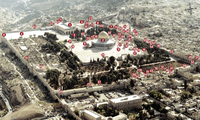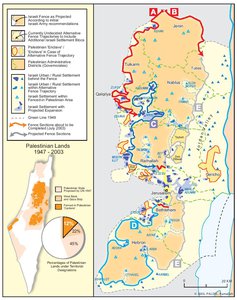ISRAEL'S SEPARATION BARRIER, 2002
Map Details
The idea of physically separating Israelis and Palestinians is not a product of the 21st Century but can be traced back to the British government’s Peel Commission report in 1937 which proposed the partition of Mandate Palestine and population transfers in order to accommodate Jewish immigrants in Palestine and to end the conflict between the Zionist movement and the Palestinian people. Over the subsequent decades, physical separation was never realized because of Zionist convictions that the Jews have “a historical claim” to all of Palestine. Palestinians rejected partition on the grounds that it would only lead to a greater loss of their homeland. Late Yitzhak Rabin, who served as prime minister from 1974 until 1977 and later from 1992 until his assassination in 1995, has been referred to as ‘the intellectual father’ of the current separation barrier.1 The first step towards this physical separation came in 1993 when Israel imposed the military closure of the West Bank and the Gaza Strip by erecting checkpoints and preventing Palestinians from entering Israel and Jerusalem. In 1994, Rabin’s government built the Gaza Strip barrier and one year later, Rabin formed a special commission to discuss further plans for separation of Israelis and Palestinians, yet his assassination in 1995 prevented the realization of his vision of a West Bank wall. With the outbreak of the Second Intifada in September 2000, demands for an accelerated implementation of a unilateral separation plan, which had been considered by Israeli governments since 1996, became louder. One month later, Israeli Prime Minister Ehud Barak approved the decision to establish an array of barriers and other hindrances to systematically control the entry of people from the West Bank to Israel. After the electoral defeat of Barak in January 2001, the Sharon Government adopted the project and eventually mapped out a route for a separation barrier that runs deep into the West Bank in order to “to prevent the penetration of terrorists from the area of Judea and Samaria into Israel.” On 23 June 2002, Israel’s Cabinet Decision No. 2077 approved the first phase of a continuous barrier east of the Green Line and around Jerusalem, as well as a 20 km buffer zone west of the Jordan River and the continued presence of Israeli military forces in the West Bank. The decision stated that the barrier “is a security measure” that “does not represent a political or other border” and that the PM and MD would decide on the exact and final route. The first section of the barrier, extending 175 km from the northern West Bank area near Salem village to the Elkana settlement southeast of Qalqilya, also included a 22 km segment in the north and south of Jerusalem. The second phase of construction extended the barrier to Tayassir village in the north-east of the West Bank and marked the beginning of the separation of the Jordan Valley from the rest of the West Bank. Subsequently, barrier segments around municipal Jerusalem and stretching southwards from the Elkana settlement were approved. The barrier, including a 30-100-meter wide ‘buffer zone’, has taken on a number of forms. It consists of eight-meter high structures of solid concrete lined with watchtowers and patrol roads in some areas, and a series of fences, some of which are electric, as well as trenches, barbed wire and sensors in others. International condemnation of the separation barrier has been widespread. The UNGA passed several resolutions condemning the barrier and demanding “that Israel stop and reverse the construction of the wall in the Occupied Palestinian Territory, including in and around East Jerusalem, which is in departure of the Armistice Line of 1949 and is in contradiction to relevant provisions of international law.” The UNGA also warned that the construction of the barrier involved "the confiscation and destruction of Palestinian land and resources, the disruption of the lives of thousands of protected civilians and the de facto annexation of large areas of territory" and that the project had a "devastating impact […] on the Palestinian civilian population and on the prospects for solving the Palestinian-Israeli conflict and establishing peace in the region." The International Court of Justice issued an advisory opinion in 2004, saying that the barrier violates international law and impedes the Palestinian right to self-rule as it goes far beyond what is permissible for an occupying power under international humanitarian law. The Court ruled that Israel must “cease forthwith the works of construction of the wall being built in the Occupied Palestinian Territory, including in and around Jerusalem”, which could become tantamount to an annexation of Palestinian land, and must return seized property as well as compensate Palestinians for damages suffered. Likewise, the European Commission has repeatedly voiced that it considers the barrier illegal and has urged the Israeli government to remove it from occupied Palestinian land.
Related Maps
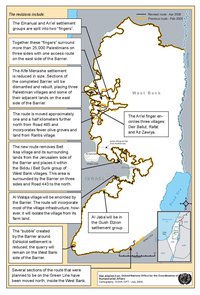
REVISED ROUTE OF THE ISRAELI SEPARATION BARRIER, 2006
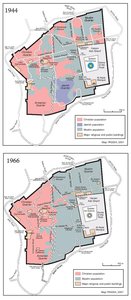
THE OLD CITY, 1944 & 1966
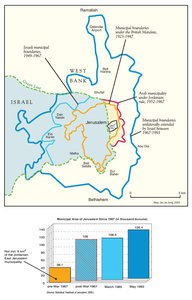
MUNICIPAL BOUNDARIES OF JERUSALEM, 1947-2000
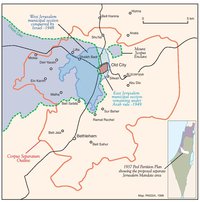
JERUSALEM AND THE CORPUS SEPARATUM PROPOSED IN 1947
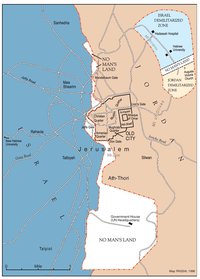
PARTITIONED JERUSALEM, 1948-1967
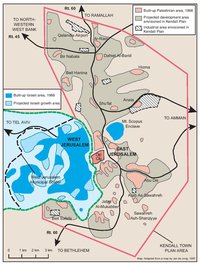
THE KENDALL TOWN SCHEME, 1966
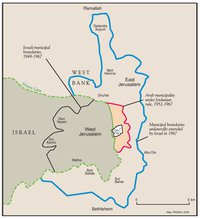
JERUSALEM AFTER THE 1967 WAR
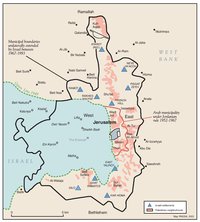
ISRAELI SETTLEMENTS AND PALESTINIAN NEIGHBORHOODS IN EAST JERUSALEM, 2000
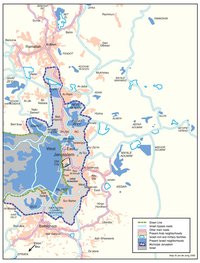
ISRAELI SETTLEMENTS AND PALESTINIAN NEIGHBORHOODS IN METROPOLITAN JERUSALEM, 2000
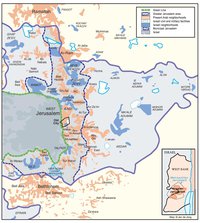
ARAB EAST JERUSALEM WITHIN ‘GREATER’ JERUSALEM, 2000
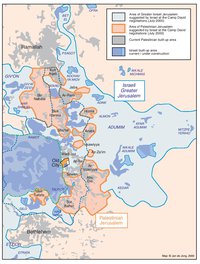
PROJECTION OF THE ISRAELI PROPOSAL FOR JERUSALEM’S FINAL STATUS AT CAMP DAVID, JULY 2000
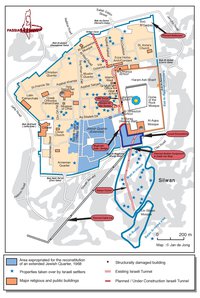
SETTLEMENT ACTIVITY IN THE OLD CITY
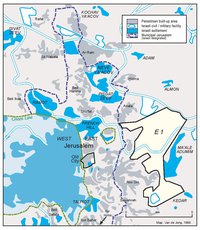
THE E-1 DEVELOPMENT PLAN
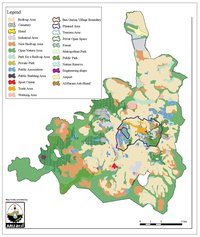
THE JERUSALEM MASTER PLAN
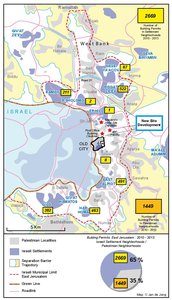
JERUSALEM TODAY (2014)
